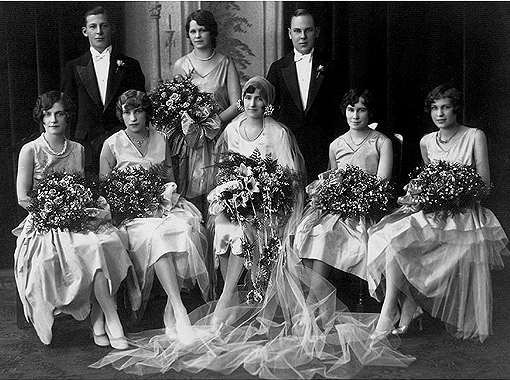
Royal Weddings from Victoria to Kate
Royal weddings have been the inspiration for many brides-to-be when it comes to planning their own wedding. wether it is the dress, the flowers, the cake or any other detail of the last big wedding.
I am looking at some of the biggest royal weddings in europe and what they did with their flowers.
As a Dutch Master Florist, with great love for our Dutch Royals living and running 3 Flower shops in Ireland, where we do not have our own Royals but more or less adopted the british Royals, I have put together a chronological list of royal weddings focussing mostly on the Dutch and British Royals.
Queen Victoria 1840
Queen Victoria. She married her first cousin, Prince Albert of Saxe-Coburg and Gotha, in 1840.
As for her bouquet, Queen Victoria carried a small posy made up solely of snowdrops (Prince Albert’s favorite flower). In reference to bridal bouquets, there is a royal wedding tradition of brides including a sprig of myrtle in their bouquets. This bush was grown from a cutting brought from Coburg by Prince Albert. Sprigs have been included in the bouquets of all royal brides since the 1850s.
The 19th century bride even decorated her gown with this symbol of fertility. But it was Queen Victoria who created the vogue for the sweet smelling blossoms when she wore them in a grand wreath for her 1840 wedding, and the classic floral theme for the Victorian bride was set. The very influential etiquette journals of the 19th century dictated that every bride include the blossoms in her wedding. This was so opulently obeyed, that by the 1870s, one of the powerful arbiters of good taste in England, John Cordy Jefferson, was begging for a change from the all-white headdresses, stating ” ‘not one lovely girl in a thousand could wear without disadvantage the solely yellow-white orange-flowers’ “, according to Ann Monsarrat. And it seems that “he also found the connection between orange blossoms and fertility extremely distasteful”. Those Victorians!
When real orange blossoms were in short supply or in northern climates where citrus fruits did not flourish, wax replicas were used instead. However, reports in society newspapers of some extravagant Victorian weddings would specify “real orange blossoms” were used and the effusive accounts of the nuptials told of lush scents wafting through the air! These exquisite folkloric flowers, either genuine fresh blossoms or wax replicas, continued to be used to “fulfill the demands of tradition” well into the 1950s. The wax reproductions so prized during the Victorian era have become extremely precious today. Whether it is an entire vintage wax flower wreath that has been restored to wear again or some individual flowers saved to nestle into a newly made headpiece, these harming wax replica orange blossoms are being treasured again, and being used for their uniqueness, beauty and sentiment.
Lady Alice 1935
In August 1935, Lady Alice became engaged to Prince Henry, Duke of Gloucester, the third son of King George V. They were married in a private ceremony, in the Private Chapel, Buckingham Palace, on 6 November of that year. A much more elaborate wedding was originally planned for Westminster Abbey; but after Lady Alice’s father died of cancer on 19 October 1935, and in consideration of the King’s own failing health, it was decided that the wedding should be scaled down to a more private setting. Her bridemaids were her sister the Lady Angela Scott, her nieces, the Lady Elizabeth Scott, Miss Clare Phipps, Miss Anne Hawkins, her husband’s nieces Princesses Elizabeth and Margaret Rose of York, her cousin Miss Moyra Scott and her husband’s cousin the Lady Mary Cambridge.
She wore a large traditional “Crescent” bridal bouquet of mainly english garden roses.
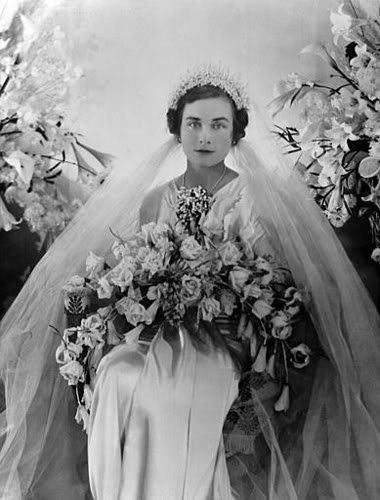
Grace Kelly 1956
On April 18, 1956 Grace Kelly and Rainier had both civil and religious weddings. The 40-minute civil ceremony took place in the Palace Throne Room of Monaco , and was broadcast across Europe. The following day the church ceremony took place at Monaco’s Saint Nicholas Cathedral. Kelly’s wedding dress, designed by MGM’s Academy Award–winning Helen Rose, was worked on for six weeks by three dozen seamstresses. The ceremony was watched by an estimated 30 million people on television.

Grace’s bridal bouquet was of lily-of-the-valley, and the ribbons of her bouquet had small sprigs attached to them. She left the bouquet on the altar of the Chapel of St. Dévote after the wedding.
Grace Kelly’s “Juliet cap” headpiece was decorated with orange blossoms.
Grace’s matrons of honor carried bouquets of tea roses, and the flower girls carried white daisies.
Queen Beatrix of Holland 1966
On the 10th of March Crown Princess Beatrix marriages Claus von Amsberg, First in a civic ceremony and later that day in a religious ceremony in Amsterdam.
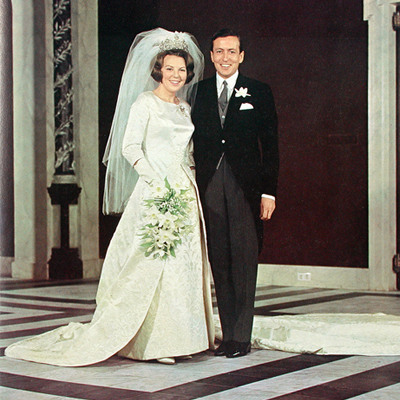
The balcony of the Palace in Amsterdam was decorated with white tulips.
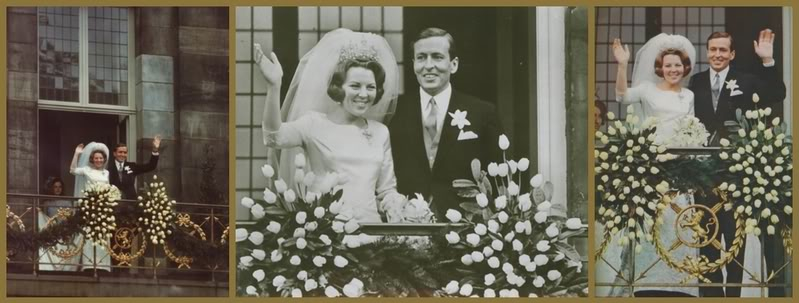
The bridal bouquet for Queen Beatrix, than princess Beatrix, was made from the pure white, stunning Eucharis flowers and white Lily if the valley flowers.
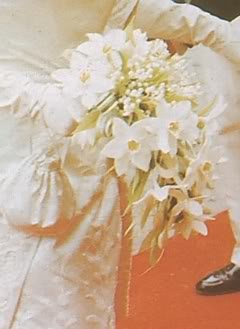
The Eucharis flower is a stunning pure white flower that at times looks like a perfect open single daffodil flower. It is however part if the Amaryllus family and is available in the spring.
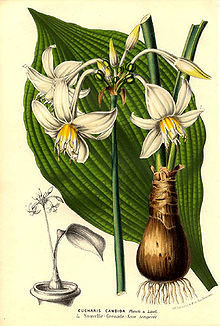
Camilla’s first wedding 1973
On 4 July 1973, Camilla married Andrew Parker Bowles, at the Guards Chapel, Wellington Barracks, London. Camilla wore a bouquet of large open “Longi” lilies and Stephanotis flowers (also called the brides flower).
Diana, Princess of Wales 1981
On 29 July 1981 Twenty-year-old Diana became The Princess of Wales when she married Charles at St Paul’s Cathedral, which offered more seating than Westminster Abbey, generally used for royal nuptials. It was widely billed as a “fairytale wedding,” watched by a global television audience of 750 million while 600,000 people lined the streets to catch a glimpse of Diana en route to the ceremony. At the altar Diana accidentally reversed the order of Charles’s first two names, saying Philip Charles Arthur George instead. She did not say that she would “obey” him; that traditional vow was left out at the couple’s request, which caused some comment at the time. Diana wore a dress valued at £9000 with a 25-foot (8-metre) train. The couple’s wedding cake was created by Belgian pastry chef S. G. Sender, who was known as the “cakemaker to the kings.”
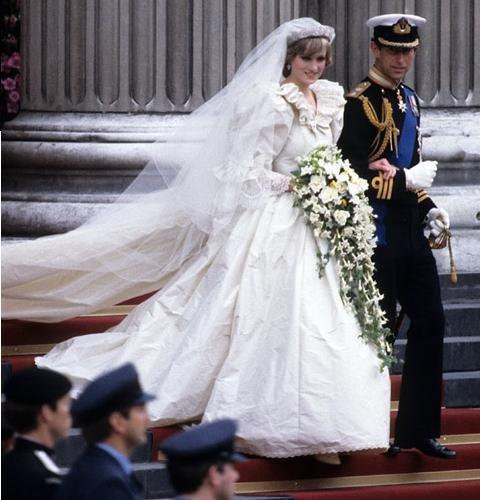
Diana wore a large cascading wedding bouquet of white roses white scented stephanotis flowers. The wedding bouquet that Diana, Princess of Wales carried for her wedding in 1981 was made by Longmans Florists, who also designed and made the bouquet for the Queen when she married in 1947. The bouquet was a gift from the Worshipful Company of Gardeners.
The bouquet, 42″ long and 15″ wide, was of a cascading shower design similar to those from Edwardian times. It set a trend for wedding bouquets which up to that point at been comparably small. The designers of her wedding dress, David and Elizabeth Emanuel wanted Diana to have a large bouquet, as a small one would have obviously been dwarfed by the size of her dress. The flowers that comprised the bouquet were:
Gardenias, Stephanotis, Freesia, Odontoglossum Orchid (Royal Wedding), Lily of the Valley, Earl Mountbatten Roses, Hedera (Ivy), Tradescantia, Myrtle and Veronica (Hebe)
It’s worth noting that it is a royal wedding tradition for a sprig of myrtle, from the bush grown from the original myrtle in Queen Victoria’s wedding bouquet, to be included. The Earl of Mountbatten roses were a tribute to Prince Charles’ “Uncle Dickie” Lord Louis Mountbatten, who had died in 1979. The yellow color of the rose incidentally inspired the bridesmaid dresses.
Three bouquets were made, one for the practice the night before the wedding, the second was delivered to St. James’ Palace. The third was taken to Buckingham Palace on the day of the wedding and used for the formal photographs. As per royal wedding tradition, at least one of them would have been placed after the wedding on the tomb of the Unknown Warrior in Westminster Abbey.
According to the press release for the wedding bouquet: ‘It is well balanced,and although heavier than most carried nowadays the distribution should not be too tiresome for the Bride.’
Whatever the weight, lets hope there was no bouquet toss; she could have seriously injured someone in the process!
Prince Andrew and Sarah Ferguson 1986
On 17 March 1986, Prince Andrew, Duke of York (the second son of Queen Elizabeth II and Prince Philip, Duke of Edinburgh and fourth in line to the throne) and Sarah Ferguson announced their engagement, having met at a party at Windsor Castle the previous year.
After securing the Queen’s permission (which is required by British law for children of the monarch) Andrew and Sarah were married in Westminster Abbey on 23 July 1986.
In her arms, Sarah carried a crescent-shaped bouquet created from gardenias, cream lilies, yellow roses, lilies of the valley and a sprig of myrtle – traditional in all British royal wedding bouquets.
Dutch Crown Prince Willem Alexander Maxima 2002
Dutch Crown Prince Willem Alexander marries Maxima from Buenos Aires (Argentinië) on 2nd of Feb. 2002.
After the wedding ceremony Prins Willem-Alexander and Prinses Máxima tour trough Amsterdam in the golden Carriage.
This carriage was also used in 1966 for the wedding of the current queen of The Netherlands, than, Princess Beatrix en Prince Claus, in 1937 for the wedding of Beatrix’s mother than Prinses Juliana en Prins Bernhard and in 1901 for the marriage of queen Wilhelmina and Prins Hendrik.
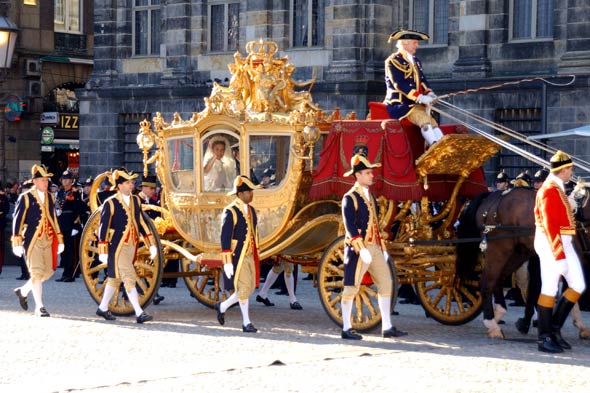
Maxima choose a compact bouquet with a slight teardrop shape with the magnificently scented Gardenia flowers, pure white roses and Lily of the Valley flowers for her wedding bouquet.

The balcony was decorated with large white lilies, white roses, green Viburnum flowers and white gypsophylla flowers.
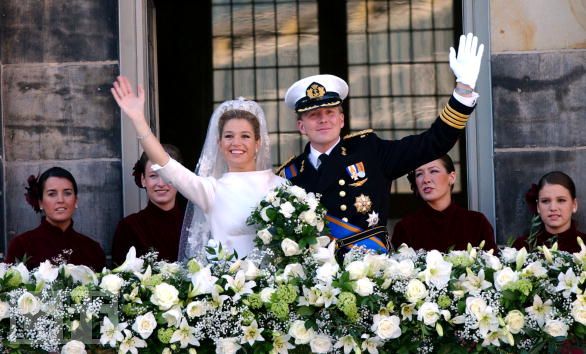
Camilla Parker Bowles 2005
On April 9 2005 Camilla Parker Bowles wed Prince Charles. Williams father. As this was a second marriage for both of them it was kept low key and Camilla wore a silver silk wedding gown, teamed with a stunning hat created by milliner Philip Treacy.
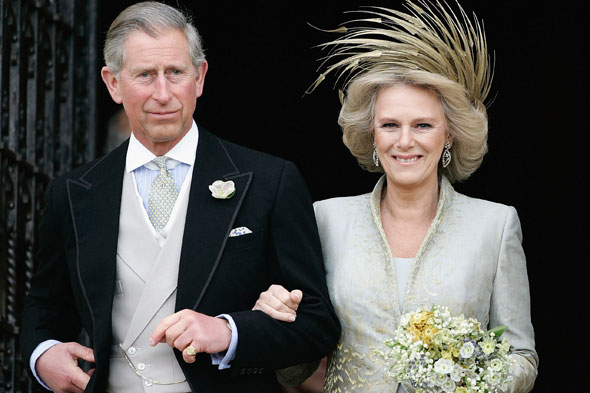
Her bouquet consisted of yellow, purple and white primroses with traditional lily of the valley flowers and myrtle foliage. Like many Royal weddings, her bouquet contained flowers mostly taken from Queen Victorias garden on the Isle of Wight.
Laura Parker Bowles 2006
On 6 May 2006 Laura Parker Bowles, daughter of Camilla Parker Bowles, married Harry Marcus George Lopes (former Calvin Klein Model), born 7 October 1977, son of the Hon. George Edward Lopes and his wife, the Hon. Sarah Violet Astor. Lopes is also a grandson of the 2nd Baron Roborough and the 2nd Baron Astor of Hever. The wedding took place in St. Cyriac’s Anglican Church, Lacock, Wiltshire. Laura wore a diamond tiara on her wedding day that belongs to her mother’s family. Some 400 guests attended the wedding, including Kate Middleton, the fiancée of stepbrother Prince William.
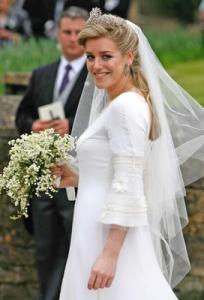
She had a very simple choice of flowers for her bouquet, all one type of flower, and her choice was Lily of the Valley… and lots of it. Laura’s bouquet was in a cascade shape, and surely was the result of some floral designer going home with terribly aching fingers and hands. Each spring of L O V has to be individually wired and taped, and with meticulous care, for their stems are very fragile. I would think that a team of designers and floral shop employees teamed up for the wiring and taping of all these tiny stems, probably to be brought together into one bouquet just hours before the ceremony. Lily of the Valley, not only fragrant, delicate and pretty, is also difficult to keep fresh once the smaller shoots are cut from the main stem or “pip”. At any rate Laura’s bouquet is a lovely one, and well worth the intense labor and technique involved.
Prince William & Kate Middleton 2011
Three florists, including Simon Lycett (who did Prince Charles and Duchess Camilla‘s wedding) are preparing flowers for the grand event. Among the stems: gardenias, lily of the valley, delphinium and roses all grown in Britain. “It will be white and very scented, along the lines of an English garden.
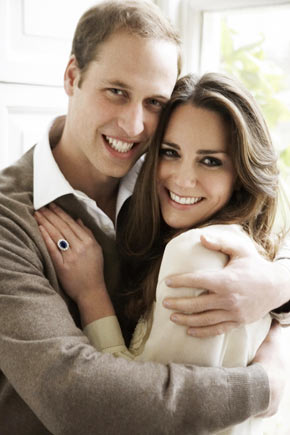
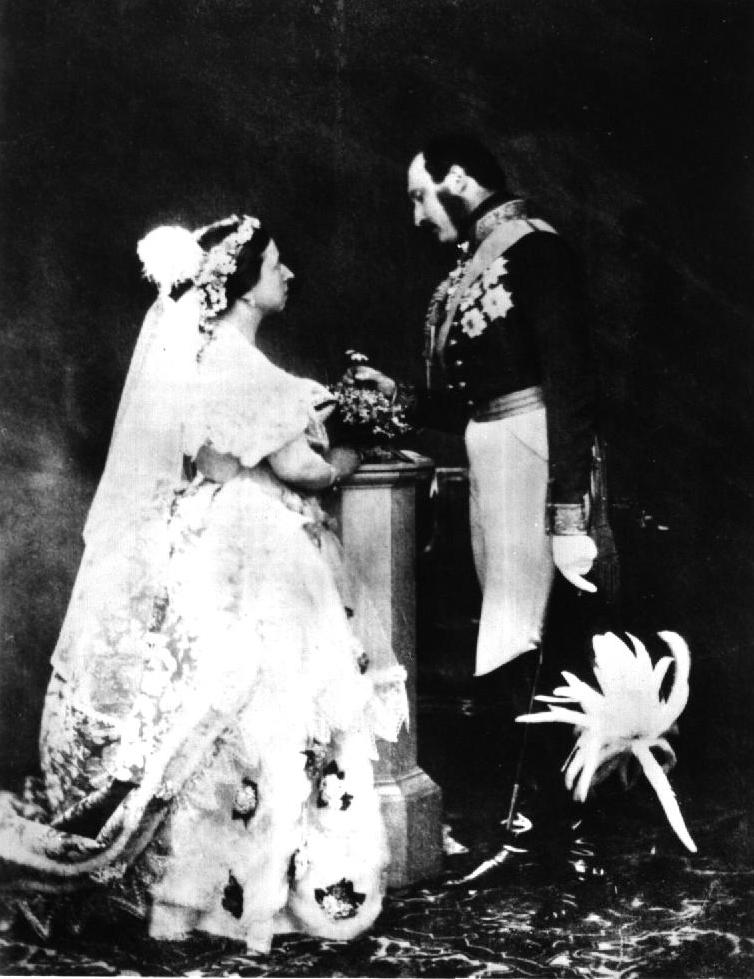
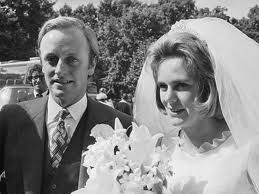

Excellent history on royal family flower usage. Looking forward to seeing what flowers will be used in the upcoming nuptials at the end of this month.
This was a fantastic essay to read! I’m a pressed flower artisan who specialises in wedding bouquet preservation. I really liked your article.
https://www.kingdomofcakes.in/
I don´t even know about this flowers but it makes looks so good with all people.
[…] Noch mehr royale Bräute gibt es hier zu sehen: lamberdebie’s blog […]
This was such a fascinating article! I am a pressed flower artist, specializing in preserving wedding bouquets. I enjoyed your article so much that I posted it on my facebook page! http://www.facebook.com/Annie.Fentz
Thanks!
Annie Fentz
Pressed Garden
Kate and Wills flowers were absolutly stunning!
The picture of Victoria and Albert is not a wedding portrait. No pictures were taken of Victoria’s wedding. This was later.
This is a good piece of content, I was wondering if I could use this blog on my article about wedding flower problem, I will link it back to your website though. If this is a problem please let me know and I will take it down right away.
No problem. Feel free to use this and I appreciate the link back. Lamber.
Wedding dress and copy of wedding cake and wedding bouquet of Kate Midleton on display in London.
http://www.dailymail.co.uk/femail/article-2017716/Buckingham-Palace-Duchess-Cambridge-Queen-view-Kate-Middleton-wedding-dress.html
Interesting article about flowers of the royal weddings! I enjoyed reading this. This is my first time to encouter one in which the flowers were discussed in conjunction with the rich history of royal weddings. Just a wonderful idea to have known this. Thanks!
C’est quand que l’on aura la possibilité de décorer un mariage princier…? Lol faut bien rêver! non?
[…] your greenery, back in the day, herbs were the go-to for wedding bouquets, until Queen Victoria (the original flower crown bride!) brought flowers into fashion with her snowdrop […]
hi
princess sarah is poor and stupid
olanzapine is cheap
you need a lot of sleeping pills
a great blog to follow up thanks for sharing
Very nice history presentation
Very nice history presentation
[…] en el pasado se preferían las hierbas medicinales para los ramos de boda, hasta la reina Victoria (la novia original de la corona!) trajo flores de moda con su ramo de […]